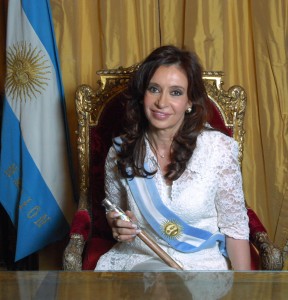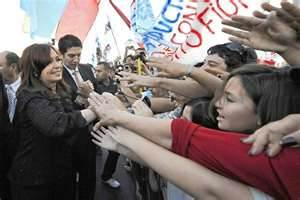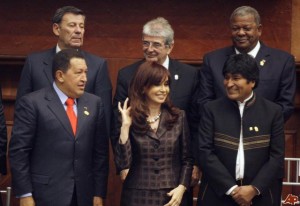Five Years of Presidency, What Should be Remembered of Cristina Fernández de Kirchner?
Cristina Fernández de Kirchner was elected to presidential office in 2007 with the assumption she would be a mere puppet to her husband, Néstor, the previous president. Since then, after being unexpectedly widowed, she has proven those criticisms to be grossly off the mark. Cristina has proven herself to be a strong and determined leader of Argentina, comparable to the iconic female political figures of Eva Perón and Hillary Clinton, recognizable women who have shaped the political process of a continent. In 2012, Forbes magazine named Kirchner 16th on its list of the world’s 100 most powerful women. [1] She has shown that her decisive changes to Argentine politics have rippled throughout Latin America. This is perhaps most evident in the nationalization of the formerly private Spanish oil company YPF, done in the hope of revitalizing the Argentine economic sector. While foreign critics have dismissed this reform as a desperate move, Argentina’s economy appears to be growing with the country greatly supporting the measure. [2]

Early Politics
Cristina became politically active in the 1970s by joining the Peronist Youth movement of the Justicialist Party. During this period, Cristina married Néstor Kirchner, both of whom graduated with law degrees from the National University of La Plata. However, Cristina was forced to step away from politics due to the persecution of political activists under the military junta from 1976-1983. As a result, the Kirchner couple opened a prosperous law practice in the province of Santa Cruz to continue engaging with community affairs. In 1989, Cristina once again entered into politics when she was elected to Santa Cruz’s provincial legislature, winning a second term in 1993. After serving at the provincial level, Cristina represented Santa Cruz in the Argentine Senate. Cristina was the first of the Kirchner couple to move to politics at the national level. After time in the Senate, she won election to the Chamber of Deputies, Argentina’s lower house, after which she returned to the Senate in 2001.
Cristina was a strong supporter of her husband’s bid for the presidency in 2003, which he won after a run-off election against incumbent Carlos Menem. She used her position as senator to promote her husband’s administration and help pass his measures in legislation. During this period, Cristina’s “combative speech style polarized Argentine politics and drew comparisons to Eva Perón,” according to the New World Encyclopedia. [3] In October 2005, Cristina once again won election to the Senate to represent the province of Buenos Aires in a heated race against Hilda Gonzaléz de Duhalde. While many believe that Cristina rode to power on the coattails of her husband, they fail to recognize that she was the first to enter the national arena.
One of the toughest obstacles Cristina has had to overcome in her political career is the prevalence of machismo. For many, machismo, “a strong or exaggerated sense of masculinity,” is seen as an integral part of Argentine national identity. [4] Although machismo pervades Argentine culture, the participation of women in politics has been promoted through the Ley de Cupo (quota law), which mandates that a certain percentage of candidates for political posts must be women. [5] While this law makes it easier and more acceptable for women to enter politics, there is still an assumption that there is a man pulling the strings. This was especially true during Cristina’s first campaign for the presidency. Many voters assumed that Néstor would be acting as the overseer of if she won, and thus supported Cristina’s campaign. However, Cristina cultivated a political identity unique from her late husband while still providing continuity in the executive branch.
Throughout her presidency, Cristina has overcome gender discrimination within the political community. Critics often bemoan her as outspoken and vain because of her strong rhetoric and perceived obsession with her appearance. Instead of downplaying her gender, as other female politicians have strategized, Cristina has used it to her advantage.

Presidency
Cristina’s first campaign for presidency was based largely on the promise to expand the economic and social reforms that her husband started. This provision of continuity helped her win the election with a 22 percent margin. With her history of legislative experience and interest in foreign affairs, many believed the new leader would improve diplomatic relations with other nations, such as the United States and Europe, an area in which her husband’s critics portrayed him as weak. [6] Throughout her first term, la presidenta continued the work of her husband by reestablishing and taking control of Argentina’s economic and political foundations.
Rising inflation and mounting protests against changes in agricultural policies led to a fall in Cristina’s approval ratings during the first term of her presidency. As she approached re-election, public disenchantment with the economic policy, combined with accusations of an establishment of a dynastic regime, proved to be a significant challenge in her reelection campaign. Néstor’s sudden death, at first quieted these concerns, but continued to actively campaign, during which Néstor was a constant presence in Cristina’s public speeches.
Amidst these difficulties, Cristina continued with her campaign and won a second term with 54 percent of the vote.
Policy
As her second presidential term unfolded, Cristina continued many of her husband’s policies. She continued to focus on adding to agricultural exports, as well as increasing import regulations and encouraging local manufacturing. Through the increase of exports and strict regulation of imports, Argentina experienced significant economic growth under the Kirchner presidency. Between 2002 and 2007, the industrial sector experienced an overall increase in production of 52 percent, a positive sign for the administration. [7] This increase in industrial production allowed the country to expand its exports, which led to a fall in unemployment levels. Moreover, in this six-year period, unemployment also decreased by 5.9 percent. Most significantly, between 2000 and 2005, Argentina’s GDP grew at a rate of 9.2 percent. [8] During her first term, Cristina adopted a more conciliatory position towards investment by reopening negotiations with the Paris Club, an informal group of financial officials, to pay off defaulted debt. At the same time, she invited the IMF back into Argentina, signifying a promising change to foreign investors. However, the recent nationalization of YPF, while popular with the Argentine people, has discouraged foreign investment. Still, the overall strong economic turnaround has buoyed Cristina’s presidency. Two years after she took office, unemployment shrank from 10.6 percent in 2005 to 7.9 percent. [9] Although this figure was significantly lower than its 2001 peak of 25 percent, by the time Cristina ran for re-election, unemployment decreased once again to 7.3 percent, the lowest rate in the past two decades.

However, the increase in capital has primarily remained with large enterprises at the top of the economic pyramid. [10] While other left-leaning countries in the region, such as Bolivia, have utilized their economic growth to redistribute wealth, Argentina’s gains remain severely stratified. At the end of Néstor’s first year in office, for example, 51 percent of the population lived below the poverty line and the level of extreme poverty continued to increase. [11] It was not until 2009 that serious efforts were made to improve this imbalance through the Asignación Universal por Hijo (AUH), a conditional cash transfer program. This program provides school-aged children and their families with financial incentives to encourage school attendance. Moreover, this program promotes regular vaccination by providing monthly payments of up to $180 USD per child to unemployed and low-income workers. The AUH program is administered by the National Security Administration (ANSES), which has reported a significant drop in poverty and indigence due to the program [12]. In a report by the Universidad de la Plata, the AUH is called the “most transcendent social policy decision in a long time.” [13] However, many schools lack the necessary tools to accommodate an influx of such children. The schools in these poor areas are outdated and dilapidated, and classrooms are unfit to handle student expectations. This lack of funding to the schools perpetuates the stratification between the social classes and is an area in which the Argentinian administration will need to continue making reforms.
The Argentine leader also has made strides in changing the social norms of her society. In July 2010, Argentina became the first country in the region to approve gay marriage. Prior to the passage of the bill, Cristina fought against the Roman Catholic Church, stating that failure to pass the law would be a “terrible distortion of democracy” and that the time had come for the Church to realize that the social mores of Argentina were changing. [14] Cristina has continued to push Argentina in a progressive direction. In July 2012, a ceremony took place to mark the beginning of a groundbreaking new law allowing citizens to have their names and sexes legally changed without undergoing transgender surgery. [16] Cristina has led Argentina in taking steps towards the level of equality that many countries in the region continue to debate.
Conclusion
Despite initial misgivings, Cristina has successfully navigated the obstacles of her presidency. She has improved upon social reform and emerged as a decisive leader in regards to the economic security of her country. Through these decisions she has established herself as a formidable and independent politician. Like most world leaders, Cristina continues to face hardships and obstacles as the downturn of the world economy continues; however, her decisions thus far have shown her to possess enough political courage to break taboos of Argentinian society and become a recognizable leader in Latin America.
Kathleen Bacon,
Research Associate at Council on Hemispheric Affairs.
Please accept this article as a free contribution from COHA, but if re-posting, please afford authorial and institutional attribution. Exclusive rights can be negotiated.
[1] Last, Caroline Howard, ed. “The 100 Women who Run the World,” Forbes, August 22, 2012. http://www.forbes.com/power-women/
[2]Romero, Simon. “Move on Oil Company Draws praise in Argentina, Where Growth Continues,” New York Times, April 26, 2012. http://www.nytimes.com/2012/04/27/world/americas/ypf-nationalization-draws-praise-in-argentina.html?_r=1&pagewanted=all
[3]New World Encyclopedia, s.v. “Cristina Fernández de Kirchner.” August 5, 2008. http://www.newworldencyclopedia.org/entry/Cristina_Fern%C3%A1ndez_de_Kirchner
[4]Merriam Webster Dictionary, s.v. “Machismo:” http://www.merriam-webster.com/dictionary/machismo
[5] Caistor-Arendar,Ana. “Cristina Kirchner’s Moment.” Open Democracy, December 14, 2007. http://www.opendemocracy.net/article/globalisation/cristina_kirchners_moment
[6] Hedges, Jill. Argentina: a Modern History (London: I.B. Tauris, 2011), 286.
[7] Petras, James and Henry Veltmeyer, What’s Left in Latin America (Surrey: Ashgate Publishing Limited, 2009), 60.
[8] United Nations, 2010 World Statistics Pocketbook Country Profile, http://unstats.un.org/unsd/pocketbook/PDF/Argentina.pdf
[9]Ibid.
[10] Petras and Veltmeyer, What’s Left in Latin America, 59.
[11] Ibid, 65.
[12] Younker, Kyle, “Asignación Universal por Hijo, One Year Later.” The Argentina Independent, October 12, 2010. http://www.argentinaindependent.com/socialissues/development/asignacion-universal-por-hijo-one-year-later/
[13] Ibid.
[14] Barrionuevo, Alexei, “Argentina approves gay marriage.” New York Times, July 15, 2010. http://www.nytimes.com/2010/07/16/world/americas/16argentina.html?_r=1
[15] Barsotti, Natasha. “Argentina passes progressive gender ID law; will ACT follow?” Xtra! Canada’s Gay and Lesbian News. July 11,2012. http://www.xtra.ca/blog/national/post/2012/07/11/Argentina-passes-progressive-gender-ID-law-will-ACT-follow-suit.aspx


